
Arnold van Wersch werd op 26 september 1852 in Simpelveld geboren. Hij volgde na de lagere school het gymnasium in Rolduc waar hij op 12/13 jarige leeftijd uitblonk in Latijn en in kerkelijke interesses.
Na het einde van de Amerikaanse Burgeroorlog in het midden van de 19e eeuw, kwam de industrialisering op gang. Het gevolg was dat er vele immigranten naar het nieuwe land trokken. En dus ook dat er priesters nodig waren. De bisschoppen uit de Verenigde Staten richtten toen The American College of the Immaculate Conception op dat priesters moest opleiden. In 1857 kwam deze opleiding ook in het Belgische Leuven. Arnold van Wersch volgde deze opleiding.
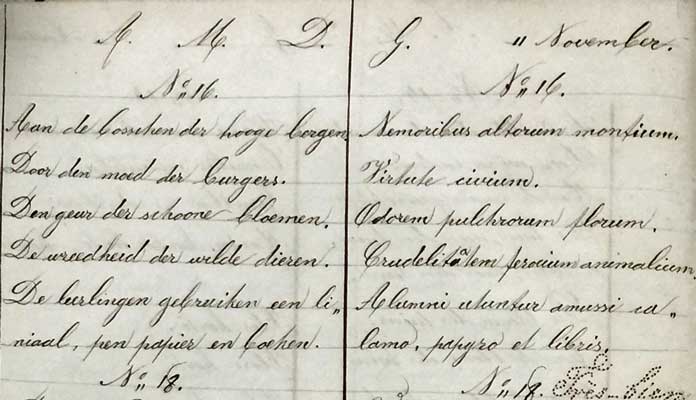
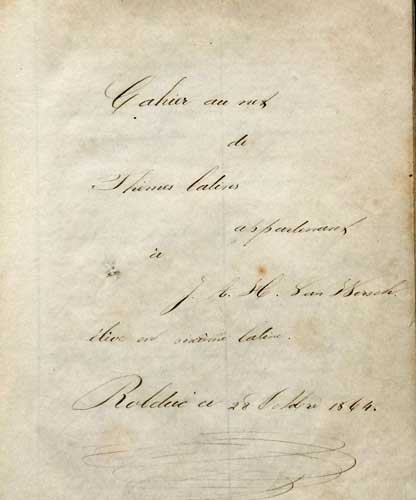
Het was dan ook niet vreemd dat hij hierna met een priesteropleiding aan het seminarie in Roermond begon, temeer daar zijn vier jaar oudere broer hem hierin al voorgegaan was. Hij werd vervolgens op 1 april 1876 tot priester gewijd en vertrok kort daarna naar Leuven om aan het Amerikaans College zijn studie voort te zetten.
Een jaar later, op 15 oktober 1877, vertrok Arnold van Wersch vanaf Oostende op 25 jarige leeftijd, naar Amerika waar hij in Willimantic (in Connecticut), samen met de Belgische pastoor Florimont De Bruycker de herderlijke taken op zich nam. De kerk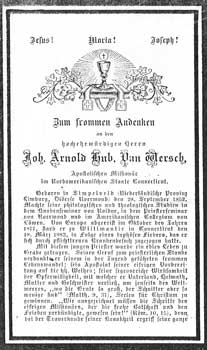 stond er net een paar jaar. De Bruycker verbouwde en vergrootte de kerk in 1873.
stond er net een paar jaar. De Bruycker verbouwde en vergrootte de kerk in 1873.
In Willimantic werd hij assistent pastoor, maar eigenlijk wilde Arnold meer. Hij wilde missioneren onder de indianen. Zijn vriend en mede-missionaris aan de westkust van Canada schreef hem dat hij er veel begrip voor had, maar raadde hem aan minstens twee jaar nog in Willimantic te blijven. En deze raad volgde hij op.
Het leven in Willimantic bevalt hem goed. Er werken veel Nederlandse en Vlaamse priesters in de regio met wie hij regelmatig contact heeft. Met een van hen maakt hij een reisje naar de Niagara Falls.
Vijf jaar na zijn aankomst, in 1883, sterft hij, na een ziekenbezoek, aan tyfus. Hij is pas eenendertig jaar oud.
Bron: samenvatting uit de serie Op zoek naar de voorvaderen door M.L.H. van Wersch, 1989.
In dit boekje staan ook enkele brieven aan en van Arnold van Wersch.
De Roermonder Courant van 1877 schreef: Tot het getal der jeugdige missionarissen welke aan het Amerikaansche seminarie te Leuven hunne theologische studiën voltrokken en in de maand October te New York aanlandden, behooren de wel eerw. heeren J. Poels. van Venray, en A. van Wersch van Simpelveld. De wel. eerw. heer Poels begeeft zich naar het bisdom van New-Ark, de wel. eerw. heer van Wersch naar dat van Hartford. Volgens een telegraphisch bericht, kwamen de moedige geloofszendelingen na een voorspoedige reis in New-York aan op Zondag den 28 October, ’s morgens ten 1½ ure.
Poels en Van Wersch vertrokken op 18 oktober 1877 per SS. White Star Brittanic van Liverpool naar New York.
In de Evening Post van mei 1882 stond het bericht dat Rev. A van Wersch met SS. De Nederland van de Red Star Lines met 35 passagiers aan boord vanuit New York naar Antwerpen vertrok. Waarom? Dat staat hieronder in een artikel uit de Amerikaanse krant.
Artikelen uit de Willimantec Chronicle van respectievelijk 1882, 1883 en 1884
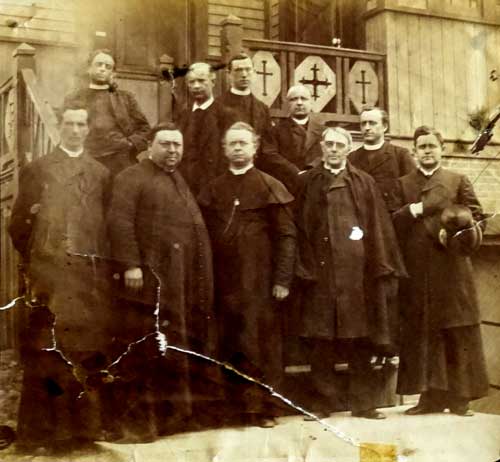
Wed Sep 13 1882: Father Van Wersch curate of St. Joseph Catholic church, who has been on a six month’s vacation in Europe started on his return trip from Antwerp, Germany, Sept. 2, and is expected home about the 14th. A large number of his parishioners held a meeting the other day and decided to arrange a grand reception for him upon his arrival at this depot and for this purpose Rev. Fl. De Bruycker, Dr. T.H. McNally and Mr. J. O’Sullivan were appointed a committee to take the matter in charge. There will be a procession with torch lights and music and the church and grounds will be brilliants illuminated.
Wed Mar. 21, 1883: Death of Rev. Arnold Van Wersch.—No event which has occurred in recent years has cast so overshadowing a gloom over the Catholic portion of this community as the death of Rev. Arnold Van Wersch, which occurred at the rectory of St. Joseph’s parish last Sunday at 11 o’clock. Nor is the feeling of sadness confined wholly within that denomination, for the deceased clergyman had gained many friends by his pious actions from among the people of other beliefs. His death was as unexpected as it was surprising to his parishioners, but few knowing at the time of his demise that he was even sick. The immediate cause was a severe attack of typhoid pneumonia which set in last Friday. He was compelled to take his bed by typhoid fever one week ago last Sunday although he had been considerably indisposed for a fortnight previous to that time, but would not give way to his feelings.
The disease was contracted, in all probability, while on missions of many to the sick. He had for a number of weeks been attending persons afflicted with typhoid fever around the vicinity of Jackson street and to his faithful ministrations to them as attributed the direct cause of his death. While service was in progress at the Catholic church Sunday forenoon the sad intelligence was announced to the congregation by Father De Bruycker, and the vast assemblage as one man burst into tears, so much had the dead priest entwined himself into the affections of that people. Father Arnold, as he was familiarly known, was personally really one of the salt of the earth. His always polite, modest and charitable actions had gained for him universal respect throughout this entire community and he always seemed to be carrying out in his every day walks a character which was thoroughly pious.
He had without effort endeared himself in a remarkable degree to the people under his charge. Father Arnold Van Wersch was born in Simpleveld, a small county village in Holland, on Sept. 18th 1852 and was therefore 30 years of age. His parents followed the pursuit of agriculture. He was one of a large family of children, another of whom is an eminent priest in that country. His education was liberal and he had profited greatly by it in his standing among his brother clergymen.
He first graduated from the Rolduc literary college in Holland and afterwards took the entire course in the theological seminary in Roermond in the same country. In both of these institutions he carried off the highest honors among a class of eighty-five members. He then entered the world-famed Catholic university of Louvain in Belgium, but before he had finished the course he consented to forego the privilege of becoming a D.D. to supply a demand for more priests. He intended at a latter period to complete that course. He was ordained in 1876. Five years ago he was assigned curate in St. Joseph’s parish in this place and has remained here ever since. He had gained the respect and love of his pastor, Rev. Fl. De Bruycker, who had a high opinion of his abilities and does not hesitate to say that in matters of dogma where he himself was in doubt he would often consult his assistant always with perfect success. The position was conceded to him by the entire clergy of this diocese of the leading exponent of theology, notwithstanding the fact that he was only a curate.
The funeral ceremonies commenced at 10:30 o’clock and continued until nearly 2 o’clock in the afternoon. The people began to gather at an early hour and long before the service began there was not room inside and hundreds were turned away from the door. It is estimated that the attendance was about 2,000. The church was festooned with flowers and the sanctuary bore appropriate mottoes for the occasion and was heavily draped with crape. Near the railing to the altar the remains were placed Sunday night at 9 o’clock and at no period since that time had there been less than a hundred mourners present in the church. They were laid by Undertaker Casey in a hard wood casket with raised top, covered with broadcloth and velvet and mounted with elegant silver trimmings. On the cover lay two plates, one giving the name and age, the other the places of nativity and death, and also lavish floral tributes.
The order of exercises were as follows: Commencing by chanting the office of the dead, at the first nocturn, Laudes, (solemn chanting); High mass, celebrant, Rev. Fl. De Bruycker; deacon, Rev. A. Van Oppen, Meriden; sub-deacon, Rev. J. VanDeNoort, Baltic; assist. Priest, Rev. E. Vygen, Putnam: Chanters with cope: Rev. J. Campbell, South Manchester; Rev. T. Ariens, Dayville; Master of ceremonies, Rev. T.W. Brockerick, new London; assistant at shrine, Rev. J. Princen, Danielsonville. The oration in French was delivered by Rev. T. Arien of Dayville. This was followed by a panegyric in English by Rev. Peter DeRoo, of Baker City, Oregon. Bishop McMahon then pronounced the last rites over the body and the cortege was formed as follows: Bearers: Revs. Shahan, Desmond, McKeone, Fones, Sheridan, Dougherty, Cooney, Thompson; friends, (men appointed); Knights of the Sacred Heart: a colyte clergy; corpse and celebrants; Children of Mary; friends (members of congregation). The remains were placed in a brick vault in the church yard at the south west corner of the church. The spot will probably be marked by a monument to his memory at a future day. Forty priests took part in the funeral ceremonies.
20 maart 1883: Artikeltje uit The Hartford Courant of Hartford Connecticut, :
Windham County, Willimantic.
Rev. Father Arnold, a young priest who has served as an assistent to Rev. Fl. DeBruyker for several years, died Sunday at 11 o’clock a.m. He was an exceedingly pleasent gentleman and was universally loved and esteemed by the catholic people of this vicinity. His funeral will take place to-day (Tuesday) at St. Joseph’s church.
Mar 12, 1884: Next Tuesday, the 18th March occurs the anniversary of the death of Rev. Father Arnold Van Wersch, the former faithful and pious assistant of Rev. Fl. Debruyckere and who was so much beloved by the Catholic people of this village. It will be noticed by the people of that parish in a public and solemn manner at St. Joseph church. Solemn requiem mass will be said for the departed at 10 o’clock and Rev. Father Broderick of St. Peters church Hartford will deliver a sermon in memoriam. It is expected that a large number of priests of this diocese will be present and assist in the services, and it is announced that the Right Reverend Bishop McMahon will be present at the ceremony. At the close of the religious services the monument erected from the contributions of parishioners and friends will be unveiled by the Bishop. We are requested to announce that the general public are invited..
 21 april 1883: De Katholieke Limburger
21 april 1883: De Katholieke Limburger
Wij lezen in The Willimantic Conn. Journal van 23 Maart. Het doodsbericht van den eerw. J. Arn. H. Van Wersch, of zooals men hem doorgaans noemde Vader Arnold, hulppriester in St. Joseph’s kerk is op ons volk als eenen schielijken, pijnlijken schok komen neervallen, daar zijn gevaarlijke ziekte niet algemeen gekend was. Weinigen inderdaad konden zich overtuigen, dat hij die des Zondags te voren de zachte tonen nog zoo welluidend aanhief nu in den doodslaap lag. De eerw. pastoor de Bruyckere, had zijn verzwakking reeds lang waargenomen, en spoorde hem aan, alle mogelijke rust te nemen, en zich te wachten, van het bezoeken door zieken, daar hij zelf ziek zijnde, zijn eigen leven daardoor in gevaar stelde. Maar de vriendelijke raadgevingen, ofschoon niet rechtstreeks van de hand gewezen, werden niet stipt gevolgd, omdat hij de vervulling van zijn heiligen plicht jegens zijn evenmensch hooger schatte dan zijn eigen leven. Hij bleef aldus zijn dagelijkschen plichten vervullen door de zieken te bezoeken en troost en hulp aan de armen en stervenden te brengen, tot eindelijk zijne uitgeputte krachten hem beletten zijn werk voort te zetten.
Op Maandag en Dinsdag wandelde hij nog om het huis, maar Woensdags werd hij door eene hevige koorts overvallen, die dermate toenam, dat hij Zondag daaropvolgende in den Heer ontsliep. De parochianen, die van den gevaarlijken toestand van hunnen herder ten deels bewust waren, werden geheel en al terneer geslagen, toen de eerw. pastoor de Bruyckere onder de H. Mis de leden der parochie bekend maakte, dat vader Arnold de eeuwigheid was ingetreden, om den loon van zijn ijverig strijden voor der zielen zaligheid van zijnen evenmensch uit de handen van zijn schepper te gaan ontvangen.
Nooit werden er tranen gestort die meer van rechtzinnige droefheid en hartzeer getuigden. Als een vreemdeling en uit een vreemd land over de zee kwam hij onder hen. Maar zijne zedige houding; ijver en zuiver karakter, zijn groot belang in hun welvaren en aanhoudende zorg en waakzaamheid trok alle harten tot hem. Hij werd niet alleen bemind en bewonderd door zijne parochianen maar door geheel het dorp zonder onderscheid van personen of gezinsleden.
Hij werd den 28 Sept. A. D. 1852 te Simpelveld, Limburg, Holland geboren. In zijne geestelijke bezigheden volbracht hij naarstig al wat een gped priester vereischt kan worden — door de zieken, armen en droefgeestigen te bezoeken en te troosten, de kinderen te onderrichten en hen tegen de kwade gezelschappen te behoeden.
Zijne begrafenis had plaats op Dinsdag 10:30 uur. De kerk was geheel in rouw behangen; en een grooten toeloop van volk, die minstens op 3000 geschat kan worden, kwam uit alle richtingen de plechtige uitvaart bijwonen. Onder het vijftigtal priesters tegenwoordig waren verscheidene Hollanders en Vlamingen, zelfs ook de weleerw. heer De Roo, van Baker City, Oregon, was er bij toeval aanwezig.
De lijkplechtigheden werden geleid door Mgr. McHahon, Bisschop van Hartford. De weleerw. heer De Bruyckere celebreerde de Mis en werd geassisteerd door de weleerw. Heeren A. Van Oppen, diaken en J. Van den Noort subdiaken, assistent E.J. Vygen, ceremonie-meester T. W. Broderick. Er werden twee treffende preeken gehouden, in het Fransch door den weleerw. heer Ariens en in het Engelsch door den weleerw. Heer De Roo. Mgr. McMahon en de andere aanwezige geestelijken zongen, als gebruikelijk is de absolutie.
De weleerw. heer J. A. Princen pastoor van Danielsonville, ook een Nederlander (Valkenburg), verliet Donderdag-morgen zijn huis om zich naar Hartford te begeven om de wïjding van den Heiligen Olie bij te wonen. Eer hij Willimantic bereikte, werd hij onpasselijk en daar aankomende werd bij door den weleerw. heer De Roo in een rijtuig geholpen en naar het huis van pastoor de Bruyckere overgebracht, waar hij om 3 uur namiddag overleed. Deze priester had slechts twee dagen te voren de begrafenis plechtigheden van den weleerw. Vader Arnold bijgewoond en nu stierf hij in het zelfde huis. De opschudding onder de geloovigen en geestelijke ambtgenooten en vooral onder de weinige Nederlandsche priesters moet wel groot zijn geweest.
Mogen de zielen der betreurde afgestorvenen in vrede rusten..
Het graf van onder andere Arnold van Wersch op het kerkhof van Willimantic in de Amerikaanse staat Connecticut. In dit graf zijn enkele priesters uit die tijd begraven. Onder andere pastoor Florimond De Bruycker (1832-1902) en pastoor J. Princen (+1883). De achternaam De Bruycker werd in Amerika veranderd in soms Debruyckere of DeBruycker(e).
(foto’s van Tom Beardsley 2005)
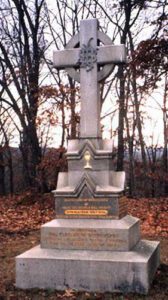

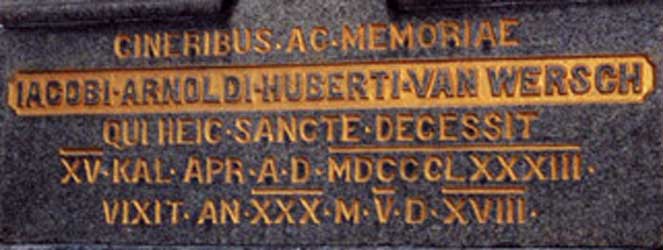
Op Palmzondag leed de St. Josephparochie door de dood van haren jongen kapelaan, den eerw. heer Arnold van Wersch, een zwaar verlies. Hoe hoog de vereeuwigde in aanzien bij de bevolking stond, bewees de buitengewoon groote 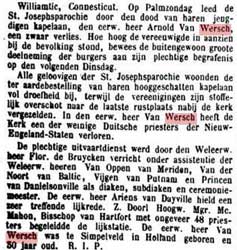 deelneming der burgers aan zijn plechtige begrafenis op den volgenden Dinsdag.
deelneming der burgers aan zijn plechtige begrafenis op den volgenden Dinsdag.
Alle geloovigen der St. Josephparochie woonden de ter aardebestelling van haaren hooggeschatten kapelaan vol droefheid bij, terwijl de vereenigingen zijn stoffelijk overschot naar de laatste rustplaats nabij de kerk vergezelden. In den eerw. heer Van Wersch heeft de Kerk een der weinige Duitsche priesters der Nieuw Engeland Staten verloren.
De plechtige uitvaardienst werd doort den Weleerw. heer Flor. de Bruyckere verricht onder assistentie der Weleerw. heeren Van Oppen, van Meridan, van der Noort, Van Baltic, Vijgen, Van Putnau, Princen uit Danielsonville als diaken, subdiaken en ceremoniemeester. De eerw. heer Ariens van Dayville hield een zeer treffende lijkrede. Z. Doorl. Hoogw. Mgr. McMahon, Bisschop van Hartford met ongeveer 48 priesters begeleidde de lijkstatie. De eerw. heer Van Wersch was te Simpelveld in Holland geboren en 30 jaar oud. R.I.P.
Een jaar na zijn dood verscheen in The Day (maart 1884) het volgende bericht:
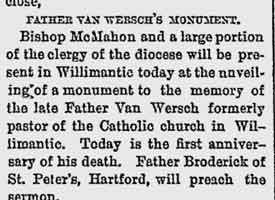
Het monument van de eerwaarde heer Van Wersch.
Bisschop McMahon en een groot deel van de geestelijkheid uit het bisdom zal in Willimantic vandaag aanwezig zijn bij de onthulling van een monument ter nagedachtenis van de overleden eerwaarde heer Van Wersch, voorheen kapelaan van de katholieke kerk in Willimantic. Vandaag is de eerste verjaardag van zijn dood. Eerwaarde heer Broderick van de St. Peter’s in Hartford zal preken.
Op 18 april 1896, dertien jaar na zijn dood, verscheen de The Sacred Heart, een lokale krant. Daarin werd Arnold herdacht met de volgende woorden:… who died of illness contracted white attending a patient afflicted with a contagious desease. Het artikel eindigde met de woorden: and whose memory is affectionately cherished by the parishioners.
Op 19 april 1876 celebreerde Arnold zijn eerste mis. Hij was 24 jaar. Die dag werd ook een herdenkingsprentje uitgereikt met deze foto erop. Aan de andere kant stond de tekst: Andenken an die erste heilige Messe des hochwürdigen Hernn Arnold Van Wersch..
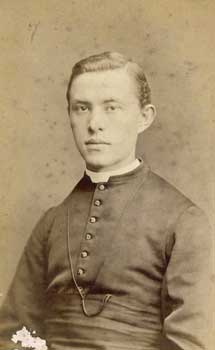
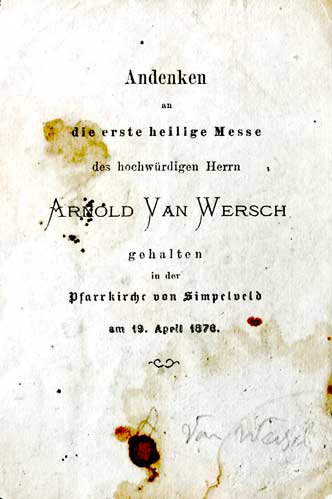
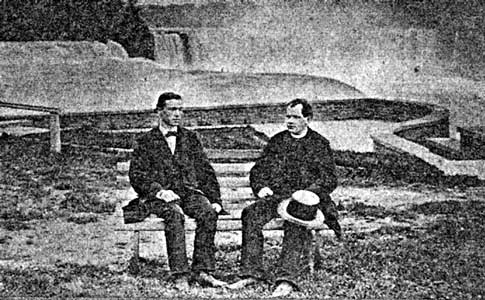
The St. Josephchurch of Willimantic.

On May 11, 1863, Rev. Florimond DeBruycker was assigned to St. Joseph parish, Willimantic, by Bishop McFarland of Hartford. Father DeBruycker was born in Ghent, Belgium on October 6, 1832. He sailed for New York on November 5, 1862 and then went on to Providence attending to the spiritual welfare of the French and German population of Connecticut and Rhode Island, which then formed the diocese of Hartford. At the time of his appointment to the Willimantic parish, the parish also comprised the missions of Baltic, South Coventry and Stafford Springs the furthest of which was up to twenty miles from the mother church.
Willimantic’s Irish population exploded in the years after the Civil War. They were joined by a large number of French Canadians, seeking employment in the town’s textile mills. Under the guidance of Father DeBruycker, the new parish began to flourish. The small Baptist Church building they bought was enlarged, refitted, and repaired. However, with the rapid growth of the congregation from many ethnic backgrounds, the old building was rendered wholly inadequate for the needs of the congregation. In 1872 steps were taken towards the erection of a new church. In May, 1873, the old church was removed to Valley Street, being now “St. Joseph’s Hall” and on its site the foundation walls for the new church were commenced.
The cornerstone of St. Joseph’s was laid with much ceremony on Sunday, April 17, 1873. Bishop Francis Patrick McFarland, of the Diocese of Hartford, being his last official act, solemnly blessed the cornerstone, situated in the North West corner of the church. His address, written in Latin, was deposited beneath the cornerstone with the latest issues of the Willimantic Journal, New York Herald, Freeman’s Journal, New York Catholic Revue, Boston Pilot, and various coins of the U.S., Ireland, England, France, Canada and Belgium and a photograph of Rev. Florimond DeBruycker.
The church was completed the following year. Its beautiful Gothic style was designed by a well-known architect, E.S. Howland. Bishop McFarland died in October of 1874 and on November 17, 1874, Bishop Bernard McQuaid of Rochester, New York, solemnly dedicated the new church. The style of the building is Gothic, with nave and aisles, and a clerestory, supported by clustered columns and arcade arches. From the basement walls, which are formed of granite, the church is built of brick.
The size on the ground is 156 x 54 feet; the height of the side walls 24 feet, and height from floor to peak of roof 66 feet. A graceful tower on the northwest corner is surmounted with a spire, the cross on the top of which is 172 feet above the curbstone. The church has fourteen double Gothic memorial windows of cathedral stained glass, and other parts of the edifice have thirty-five smaller windows. The beautiful, original high altar was brought from Munich. ‘The building is an elegant one in all its details of finish and furnishings, and had, at its dedication, a seating capacity of 1,500.
Located around the interior of the church are stained glass windows in the gothic style. At the top of each window is a symbol of some article of the Catholic faith. Over the door on the south side is the IHS (monogram of the Greek for “Jesus”) symbol, followed by the symbols for Faith (cross), Hope (anchor), and Charity (heart), the Holy Spirit, the wounding Pelican, The Sacred Heart of Jesus, the Lily and red background symbol of Saint Joseph, and the crown. Continuing, across from the crown in the window of the organ loft on the North side is the Cross, the Chalice, the Monstrance, the Nails and Crown, The Our Lady of Sorrows, the Lamb of God, and the MR’ a monogram of the Latin words Maria Regina, Mary our Queen.
Located in the walls of the apse of the Church are five large stained-glass windows, each representing Jesus or a Saint. The first window on the left is of St. John the Baptist who is standing over the river Jordan. The next window shows St. Peter who is holding the keys to the kingdom and the book of the righteous. In the center is Jesus. He is holding a book which says Alpha and Omega, representing Himself as the beginning and the end and the Word of God. Continuing to the right is St. Paul who is writing in a book symbolic of his many letters and holding a sword. The final window is St. Patrick, who is wearing a tunic with clovers on it. He is also holding his Bishop’s staff and casting the snakes out of Ireland.
The organ in the west end of the Church was installed in 1874 by the Steere & Turner Company of Westfield, Massachusetts. It was completely restored in 1989 by Charles Aitken and Son of Torrington, Connecticut. A choir division has been added and the pedal expanded while extending its compass to 32 notes.
Above the organ pipes the west rose window with its representation of Saint Cecilia, patron of musicians, floods the church late in the day with the light of the setting sun. Although the 14 memorial windows name Irish donors, the inscription in the west rose is in French and reminds the congregation of the diversity that has always characterized this community.
There are three bells in the bell tower, all made by the Clinton H Meneely Bell Company of Troy,N ew York in the late 19th century. They are made of “bell metal” not silver ’though one of them has a “silver” connection. Bell metal is a bronze alloy.
Each bell is different. Each rings its own note and each has its own inscription, some might even say its own name. Michael McCarthy, our organist and choir master, tells me that our three bell peal rings “F” “G” and “A” although the pitch of each bell may vary sharp or flat depending on the temperature. The biggest bell rings “F” and has an inscription in Latin which translates: In honor of Saints Joseph and Patrick and John the Baptist A.D. 1881 In memory of the happy return of Father DeBruycker.
The second bell sounds “G” and carries its own Latin inscription translated: In honor of the Blessed Virgin Mary Immaculately Conceived and In memory of the silver jubilee of Father DeBruycker, Rector of the church A. D. 1863-1888 My soul magnifies the Lord.
The third and smallest of the bells rings “A” and bears the inscription¼again translated: In honor of Saint Anne, Mother of the Blessed Virgin Mary Make a joyful noise to God our Savior. There is no date on this bell. At least three times each day the bells of Saint Joseph peal out. They ring at 7 am, at noon and at 6 pm to honor the Blessed Virgin Mary by ringing the Angelus: three groups of three strikes followed by a peal of all three bells. These bells call us to worship by pealing 5 minutes before each of the Vigil and Sunday Masses.
bron: Brochure St Joseph Church 2017
The Rev. Daniel Mullen succeeded Father O’Reilly, and after four years was succeeded by the present incumbent, the Rev. Florimond DeBruycker. Father DeBruycker had under his charge when he first came here missions at Stafford Springs, Bolton and Coventry.
In 1864 he purchased the new Catholic cemetery, and in 1883 the old wooden church, (bought of the Baptists) was removed to Valley street, where it is now a part of the parochial school property, and on the site of the old church he erected the beautiful structure of brick and stone at a cost of $80,000, including the high altar, which was brought from Munich. The corner stone was laid August 17, 1875, by the late Bishop McFarland, his last official act. November 17, 1874, came the dedication led by the Rev. Bishop McQuade of Rochester. Our Catholic population is from 3500 to 4000 including about 1500 to 1800 French Canadians.
bron: A Memorial Volume of the bi-centennial celebration of the town of Windham, Connecticut, Hartford, 1893. Blz 56.
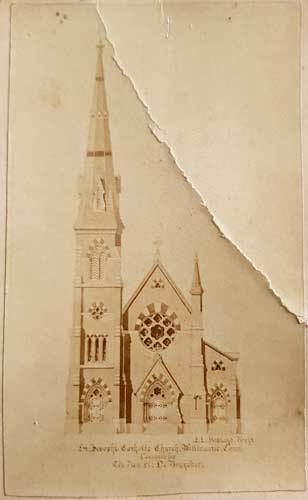
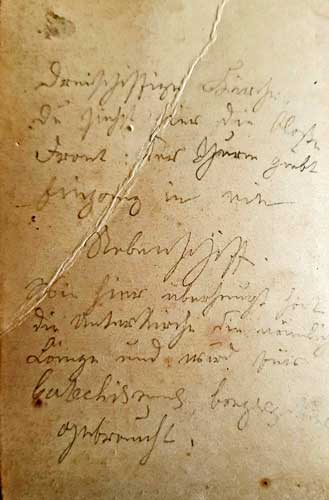
Arnold stuurde een kaart van de kerk naar zijn ouders en schreef daarop:
Dreischiffige Kirche. du siehst nur die bloße Front : der Thurm giebt Eingang in ein Nebenschiff. Wie hier überhaupt hatte die Unterkirche die nämliche Länge und wird für Catechisierung be………… gebraucht.
Klik hier voor Arnold van Wersch in de Simpelveldse Tak.

